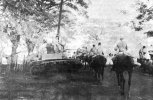MWI 41081015 The Air Reinforcement Route
Fatboy Coxy
Monthly Donor
1941, Sunday 10 August;
The leading Blenheim pilot waved his wings, and then turned into what would become a holding circle above the airfield, the next aircraft began his descent for a landing, while the last three Blenheim’s followed the leader. On the ground, RAF and RCAF officers, pilots and ground crew all paused in their efforts to watch the aircraft come in. The pilot eased the plane down, and while not quite a perfect landing it was better than many of the pilots watching would be capable of.
As she taxied off the runway so another aircraft made her descent, the rest making another circuit around the airfield. Again, a good landing, and so it continued, until it was the turn of the leader, who’s landing was beyond the criticism of any fair-minded person. For most of the people watching, the show was over, and the Seletar airfield fell back into her normality, excepting the small reception party for the five air crews.
Tomorrow, maintenance crews would begin giving each aircraft a full overhaul, the long journey, the dusty climates, and the heat would have taken a toll, despite the nursing of the planes along the way. For their pilots, it would be several days of rest and relaxation, before boarding a BOAC flight back to Egypt, where no doubt more aircraft awaited to be ferried who knows where.
The aircraft use to fly to Egypt from the old route of UK, Gibraltar and Malta, but the entry of Italy into the war had effectively closed that route. Beginning in late 1940 the British had constructed a trans African route, which required aircraft, having been built in the UK, to be disassemble and packed in crates, shipped to West Africa, where they were reassembled, and flown across Nigeria, on through French Equatorial Africa, stopping at Fort Lamy, and then on into Sudan, including Khartoum, before heading north to Egypt. Last month, over 150 aircraft had completed this route, and as facilities improved, and staff became more proficient, this number was expected to rise.
From Egypt, another air route existed to Singapore, over five and half thousand miles, flying through Iraq, Persia, across India, over to Rangoon in Burma, and then down to Victoria Point, the most southerly point in Burma, on the western side of the Kra Isthmus, before making this last leg to Singapore. It worked well, although single engine aircraft needed far more intermediate stops, owing to their shorter range. Flown by ferry pilots, flying in small groups of up to six aircraft at a time, it was a cheaper, and far quicker way of moving aircraft to Singapore from the Middle East, despite the obvious risk of aircraft breakdowns, or worse, crashes.
The numbers flying into Singapore were but a trickle, but should things turn ugly, this was how the RAF proposed to reinforce the theatre, whole squadrons following the route down. Which all sounded fine, until thoughts were given to the ground crews left behind, most of who would still have to come by ship. And the precarious route along the Kra Isthmus supposed that neighbouring Thailand wouldn’t fall into the enemy’s hands, allowing the quick capture of Victoria Point, the furthest point south for Burma, or the small airfields along the Isthmus north of it which the single engined aircraft relied on, being unable to divert onto longer flights routes, like the twin engined aircraft could. Meanwhile the shipping of crated aircraft into Singapore continued, their totals, especially Hurricanes, increasing significantly.
The leading Blenheim pilot waved his wings, and then turned into what would become a holding circle above the airfield, the next aircraft began his descent for a landing, while the last three Blenheim’s followed the leader. On the ground, RAF and RCAF officers, pilots and ground crew all paused in their efforts to watch the aircraft come in. The pilot eased the plane down, and while not quite a perfect landing it was better than many of the pilots watching would be capable of.
As she taxied off the runway so another aircraft made her descent, the rest making another circuit around the airfield. Again, a good landing, and so it continued, until it was the turn of the leader, who’s landing was beyond the criticism of any fair-minded person. For most of the people watching, the show was over, and the Seletar airfield fell back into her normality, excepting the small reception party for the five air crews.
Tomorrow, maintenance crews would begin giving each aircraft a full overhaul, the long journey, the dusty climates, and the heat would have taken a toll, despite the nursing of the planes along the way. For their pilots, it would be several days of rest and relaxation, before boarding a BOAC flight back to Egypt, where no doubt more aircraft awaited to be ferried who knows where.
The aircraft use to fly to Egypt from the old route of UK, Gibraltar and Malta, but the entry of Italy into the war had effectively closed that route. Beginning in late 1940 the British had constructed a trans African route, which required aircraft, having been built in the UK, to be disassemble and packed in crates, shipped to West Africa, where they were reassembled, and flown across Nigeria, on through French Equatorial Africa, stopping at Fort Lamy, and then on into Sudan, including Khartoum, before heading north to Egypt. Last month, over 150 aircraft had completed this route, and as facilities improved, and staff became more proficient, this number was expected to rise.
From Egypt, another air route existed to Singapore, over five and half thousand miles, flying through Iraq, Persia, across India, over to Rangoon in Burma, and then down to Victoria Point, the most southerly point in Burma, on the western side of the Kra Isthmus, before making this last leg to Singapore. It worked well, although single engine aircraft needed far more intermediate stops, owing to their shorter range. Flown by ferry pilots, flying in small groups of up to six aircraft at a time, it was a cheaper, and far quicker way of moving aircraft to Singapore from the Middle East, despite the obvious risk of aircraft breakdowns, or worse, crashes.
The numbers flying into Singapore were but a trickle, but should things turn ugly, this was how the RAF proposed to reinforce the theatre, whole squadrons following the route down. Which all sounded fine, until thoughts were given to the ground crews left behind, most of who would still have to come by ship. And the precarious route along the Kra Isthmus supposed that neighbouring Thailand wouldn’t fall into the enemy’s hands, allowing the quick capture of Victoria Point, the furthest point south for Burma, or the small airfields along the Isthmus north of it which the single engined aircraft relied on, being unable to divert onto longer flights routes, like the twin engined aircraft could. Meanwhile the shipping of crated aircraft into Singapore continued, their totals, especially Hurricanes, increasing significantly.


